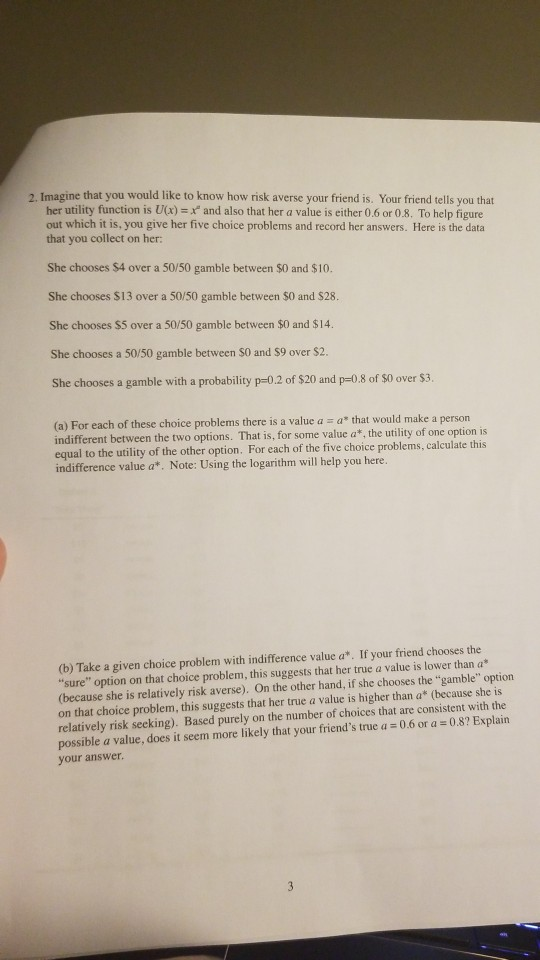Answered step by step
Verified Expert Solution
Question
1 Approved Answer
2. Imagine that you would like to know how risk averse your friend is. Your friend tells you that her utility function is U(x)x and

2. Imagine that you would like to know how risk averse your friend is. Your friend tells you that her utility function is U(x)x and also that her a value is either 0.6 or 0.8. To help figure out which it is, you give her five choice problems and record her answers. Here is the data that you collect on her: She chooses $4 over a 50/50 gamble between $0 and $10 She chooses $13 over a 50/50 gamble between $0 and $28 She chooses $5 over a 50/50 gamble between $0 and $14. She chooses a 50/50 gamble between SO and $9 over $2. chooses a gamble with a probability p-02 of $20 and p+0.8 of SO over S3 (a) For each of these choice problems there is a value a athat would make a person indifferent between the two equal to the utility of the other option. For each of the five choice problems, calculate this indifference value a. Note: Using the logarithm will help you here. options. That is, for so me value a*, the utility of one option is (b) Take a given choice problem with indifference value a*. If your friend chooses the sure" option on that choice problem, this suggests that her true a value is lower than a (because she is relatively risk averse). On the other hand, if she chooses the "gamble" option on that choice problem, this suggests that her true a value is higher than a* (because she is relatively risk seeking). Based purely on the number of choices that are consistent with the possible a value, does it seem more likely that your friend's true a 0.6 or a 0.8? Explain your answer. 2. Imagine that you would like to know how risk averse your friend is. Your friend tells you that her utility function is U(x)x and also that her a value is either 0.6 or 0.8. To help figure out which it is, you give her five choice problems and record her answers. Here is the data that you collect on her: She chooses $4 over a 50/50 gamble between $0 and $10 She chooses $13 over a 50/50 gamble between $0 and $28 She chooses $5 over a 50/50 gamble between $0 and $14. She chooses a 50/50 gamble between SO and $9 over $2. chooses a gamble with a probability p-02 of $20 and p+0.8 of SO over S3 (a) For each of these choice problems there is a value a athat would make a person indifferent between the two equal to the utility of the other option. For each of the five choice problems, calculate this indifference value a. Note: Using the logarithm will help you here. options. That is, for so me value a*, the utility of one option is (b) Take a given choice problem with indifference value a*. If your friend chooses the sure" option on that choice problem, this suggests that her true a value is lower than a (because she is relatively risk averse). On the other hand, if she chooses the "gamble" option on that choice problem, this suggests that her true a value is higher than a* (because she is relatively risk seeking). Based purely on the number of choices that are consistent with the possible a value, does it seem more likely that your friend's true a 0.6 or a 0.8? Explain your
Step by Step Solution
There are 3 Steps involved in it
Step: 1

Get Instant Access to Expert-Tailored Solutions
See step-by-step solutions with expert insights and AI powered tools for academic success
Step: 2

Step: 3

Ace Your Homework with AI
Get the answers you need in no time with our AI-driven, step-by-step assistance
Get Started


